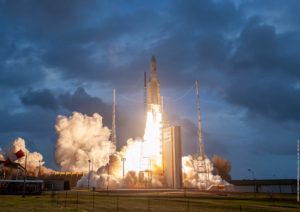Satellite’s gone?

Eutelsat Konnect taking off in 2020. Satellite operators are increasingly looking to connectivity.
Satellite’s gone up to the skies/ Things like that drive me out of my mind/ I watched it for a little while/ I like to watch things on TV.
So sang Lou Reed (Satellite of Love, released on 1970’s Transformer). But are people who like to watch things on TV still in love with satellite?
Satellites, once the mainstay of pay TV, have commonly been seen as yesterday’s technology for some time now. With fixed broadband increasingly able to deliver live-streamed video and linear consumption slowly declining, the need to rely on rooftop dishes to supply homes with TV is much diminished.
Broadcasters that previously relied on satellite, such as Sky, increasingly see streaming as the future. Next week Sky is to launch Sky Stream, the standalone version of the streaming puck it previously bundled with Sky Glass, its integrated TV offering. Whether Sky ditches the dish altogether sooner or later, the direction of travel is clear.
Where then does this leave the satellite operators that have traditionally relied on video revenues as the mainstay of their own business?
This week saw Eutelsat report revenues that were once again down year-on-year, driven lower by the declining broadcast video business. broadcast revenues are expected to decline for the full year also as a result of the anticipated non-renewal of a capacity contract with Digitürk from mid- November.
Broadcast still makes up 59% of Eutelsat’s overall revenue base, and it is not as if all other business units are thriving.
At the same time, Eutelsat is promising a brighter tomorrow as a result of its merger with OneWeb, the low-Earth orbit constellation designed to provide high-speed connectivity from space in underserved regions of the world.
At the company’s Capital Markets Day presentation, CEO Eve Berneke promised “a a decisive leap forward for satellite connectivity” from OneWeb that would deliver significant revenue growth.
Berneke said the merger would create “a powerful global player with the financial strength and technical expertise to accelerate both OneWeb’s commercial deployment, and Eutelsat’s pivot to Connectivity”.
Analysts at Berenberg were more sceptical, arguing that merger “completely changes the investment case and risk profile of Eutelsat, from one of a highly cash-generative, dividend-paying value stock to a non-cash-generative, non-dividend-paying growth company”.
It is not only Eutelsat that has lost the favour of investors. Rival SES has seen its share price tumble in recent months. Those same analysts at Berenberg bemoaned the decline in this case, making the case that the decline reflected the company’s “heavy leverage of today” rather than the “much-improved balance sheet that it will have in just over a year’s time” through the sale of C-band spectrum in the US combined with the impact of a strengthening dollar.
Berenberg’s wider analysis of “what has spooked investors”, however, includes concerns among those investors that “the outlook is bleak for geostationary orbit (GEO) constellations”.
GEO, the orbit suited to broadcast applications, is of less interest when it comes to that “pivot to connectivity” highlighted by Berneke. The pivot means M&A (as in the case of Eutelsat and OneWeb) or investment in expensive new MEO and LEO constellations. SES’s bet is on MEO via its O3b mPOWER investment, but planned MEO launches have been subject to delay, leading to frustration among those investors.
While the major focus has been on LEO and MEO plans, it is too early to call time on GEO. Satellite operators are continuing to innovate in many areas. SES has teamed up with Microsoft to virtualise elements of its ground infrastructure, focused on software-defined terminals, virtual network functions and edge cloud applications to address the use of space to extend connectivity.
Intelsat meanwhile, another Luxembourg-based operator that has been linked to merger speculation with SES, is looking to a combination of GEO and LEO with innovation in GEO based on the concept of ‘software-defined satellites’.
Speaking to DTVE at IBC recently, Rhys Morgan, Intelsat’s GM, EMEA media and network sales, said that “you need to combine all orbits” to deliver a comprehensive set of satellite solutions. He said that “software-defined satellites for GEO” will help transform the business of delivering services by satellite. This means that generic space hardware can be reconfigured and adapted as the needs of customers change.
Morgan also made the case for a continued role of satellite in broadcast, while admitting this faced long-term decline.
“There is still a role for DTH going forward – there are place in the world without great connectivity,” he said. Emerging markets are also likely to see demand for DTH for some time, while markets where consumption of video is primarily via mobile phones could be targeted by delivering video feeds to mobile towers.
Geostationary satellite has been around for a while, but it is not done yet. The question is whether satellite operators can innovate and identify new applications fast enough to secure their future while satisfying those investors who see satellite primarily as a currently cash-generative business that is nevertheless facing long-term decline.



